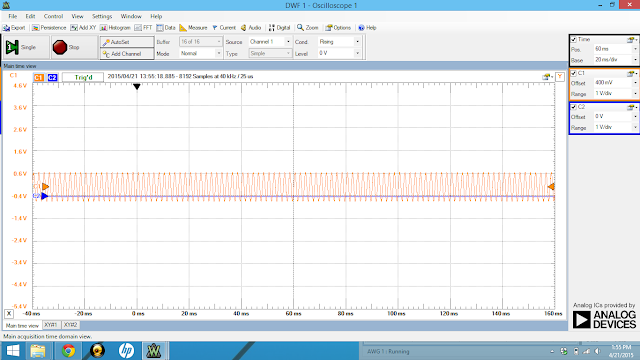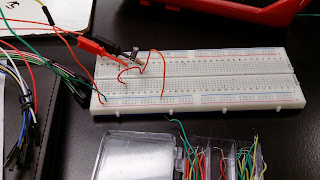Thursday, June 11, 2015
5-26-15
 |
| This is the circuit that the previous example is using the see if you can predict the voltage and current. |
 |
| This is the picture of the circuit being tested. Everything is in series. This is an extremely simple circuit. |
 |
| The resistor is really only measured to calculate the current. |
 |
| The energy is the highest in this graph. |
5-14-15
 |
| This is the voltage through an AC current at 1kHz. |
 |
| Same circuit 5kHz. |
 |
| Same circuit 500Hz. |
 |
| This chart shows the phase shifts between the voltage and the current. |
 |
| In this circuit the potentiometer is parallel in order to maximize the power across the potentiometer. |
 |
| This is the output of the circuit. Measuring the voltage as it fluctuates through the pot. |
5-12-15
 |
| This is the theoretical calculations, and what is expected to happen through the circuit. |
 |
| This is the experimental voltage and current graph, through the oscilloscope. |
Thursday, May 21, 2015
5-7-15
 |
| This is all three of the circuits built on one bread board, so that each circuit could be looked at one after another with ease. This is to calculate the voltage of the circuit |
 |
| This is the same circuit only in this case the frequency is 1K Hz. |
Sunday, May 17, 2015
4-30-15
 |
| This circuit is underdamped. Even though on the previous screen we say that it is over damped. |
4-28-15 : AC RLC circuit
 |
| This is the prelab. Though it does not include the equations for s1 and s2. The equation for underdamped i(t) = e^(-at)(B1coswt+b2sinwt) |
 |
| This graph shows the underdamped response. |
4-21-15
 |
| This circuit uses a capacitor with an inverting op amp. |
 |
| This is the graph of the output voltage at 1kHz frequency. You can see that the max is approximately 1.22 V. There is a small amount of excess noise, but the voltage is very consistent. |
 |
| When the frequency is 2kHz, there appears to be a lot more noise. This has to do with the increase in amplitude and in increase in frequency. |
 |
| This a very neat graph at 500Hz. It looks very boring and simple and it has a small amount of voltage. |
Saturday, May 16, 2015
Subscribe to:
Comments (Atom)






























